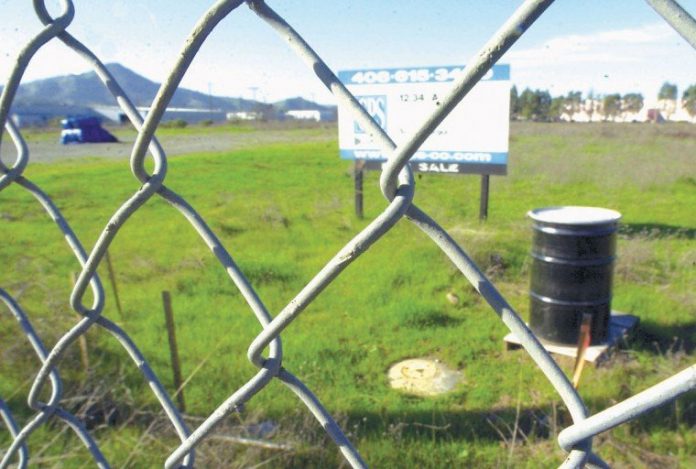MORGAN HILL
– It was one year ago today that the word
”
perchlorate
”
exploded across Morgan Hill and San Martin, destroying
confidence in the water that comes from taps and causing havoc with
government treasuries and private property values.
MORGAN HILL – It was one year ago today that the word “perchlorate” exploded across Morgan Hill and San Martin, destroying confidence in the water that comes from taps and causing havoc with government treasuries and private property values.
On Jan. 16, 2003, the Santa Clara Valley Water District and the Central Coast Regional Water Quality Control Board held a press conference and announced that perchlorate from an abandoned safety flare plant on Tennant Avenue in Morgan Hill had leached into the underground water table. Today, the toxic plume of rocket fuel ingredient stretches roughly 10 miles south all the way to north Gilroy.
The contamination has triggered class action lawsuits, calls for scientific testing and treatment plans costing millions. It has also united – and in some cases divided – those with health, real estate and agricultural interests.
Over the course of the Tennant Avenue plant’s 40-year life, the chemical had spread in a southeasterly “plume” through southern Morgan Hill and into San Martin polluting as many as 450 wells.
During the past year, residents and government officials alike learned what was available about the chemical and frequently said they mostly learned how much there was still to discover.
Sylvia Hamilton, a San Martin resident and the chair of the San Martin Neighborhood Alliance, said she was jolted to consider that a year had passed.
“It was scary when we first heard about it,” Hamilton said. “SMNA had already been formed (as a local action group), but with this one I was just at a loss. I had no idea who to contact; I didn’t even know the Regional Board existed.”
The Regional Board became the lead agency supervising the contamination’s research and eventual cleanup.
Hamilton quickly got her bearings and has led the community effort to work with officials and Olin Corp.
Little was known about the plume’s extent or the affect of perchlorate on the health of human beings and animals or on their crops. Also unknown was how much perchlorate was safe to drink.
The chemical was known to cause tumors and thyroid problems, but amounts found in most local wells were fairly low.
By sping 2003, perchlorate was detected by a City of Gilroy monitoring well and showed up in a private well off Holsclaw Road, south of Gilman Road. The plume did not trickle much further over the next several months, contaminating just a handful of private wells in the northeast section of town.
Nonetheless, it brought immediate action by Gilroy officials concerned that the city’s drinking water supply – eight wells all within a mile of the contaminated sites – would soon be next. As of December 2003, perchlorate has not been found in any of the city’s drinking water wells.
The State of California had not yet set a standard though it did mark an “action level” of 4 parts per billion. An action level is the point at which water providers must notify their customers of a pollutant’s presence in the water, though they are under no obligation to stop selling the water.
The City of Morgan Hill, however, has shut down any well with a level over 4 ppb.
The state was required to set such a standard by Jan. 1, 2004, which has not happened. Dr. Marty Fenstersheib, Santa Clara County’s health officer, said this is a consequence of the new California government.
“The new governor put a moratorium on all new regulations,” Fenstersheib said.
Unlike many other perchlorate contaminations state-and-nationwide, this culprit was both known, still in business and still financially viable. Olin Corp. owned up almost immediately to the responsibility for the problem.
Of the wells tested by Jan. 16, 2003, one showed a level of 98 ppb, two showed levels of 32 ppb and all others were at 4-10 ppb or lower.
The water district report states that adverse health effects are not anticipated from levels between 4 and 18 parts per billion (ppb).
Opinions differed, however, and Olin and the water district joined forces to deliver free bottled water to every private well with a level higher than 4 ppb.
Fenstersheib said he has spent the year getting up to speed.
“We talked, we researched, we heard from experts in PMAG (the Perchlorate Medical Action Group),” Fenstersheib said. “We can’t even begin to understand the risk until we see what is known, and that’s a key part of figuring out what needs to be done.”
PMAG was formed to communicate with the community, with state and federal officials, the medical community and the county health department, he said.
“We found in one study that a first look at newborns in the community showed no increased numbers with thyroid problems,” he said.
He expects that 2004 will bring a better understanding of the health risks and the effects, if any, from eating fruits and vegetables where perchlorate is present.
Although the southernmost city in South County remains largely perchlorate-free, Gilroy is a member of a regional perchlorate workgroup that is considering joint litigation against Olin Corp. Gilroy has also created its own perchlorate contingency plan that ensures clean water delivery to residents in the event a city well or wells become contaminated.
Like Morgan Hill and San Martin have already done, Gilroy will use bulky and costly ion exchange treatment systems to rid its water of perchlorate. The city has not yet purchased the equipment, which costs nearly $1.5 million and more than $1 million to operate, but the City Council approved a $200,000 expenditure on real estate around the city’s wells. The land is needed so the treatment system can be put in, when necessary.
Fenstersheib praised the community involvement.
“This is a great example of community organization that made the problem much more visible,” he said.













